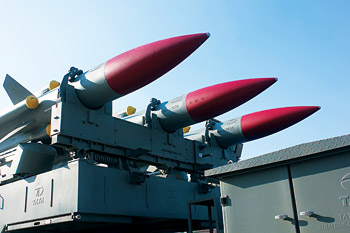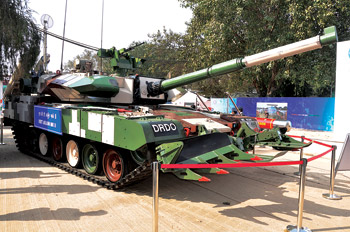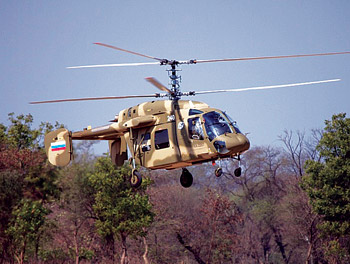INDIAN ARMED FORCES CHIEFS ON OUR RELENTLESS AND FOCUSED PUBLISHING EFFORTS

The insightful articles, inspiring narrations and analytical perspectives presented by the Editorial Team, establish an alluring connect with the reader. My compliments and best wishes to SP Guide Publications.

"Over the past 60 years, the growth of SP Guide Publications has mirrored the rising stature of Indian Navy. Its well-researched and informative magazines on Defence and Aerospace sector have served to shape an educated opinion of our military personnel, policy makers and the public alike. I wish SP's Publication team continued success, fair winds and following seas in all future endeavour!"

Since, its inception in 1964, SP Guide Publications has consistently demonstrated commitment to high-quality journalism in the aerospace and defence sectors, earning a well-deserved reputation as Asia's largest media house in this domain. I wish SP Guide Publications continued success in its pursuit of excellence.
- Prime Minister Modi Visits Punjab’s Adampur Air Base, Interacts with Airmen after Successful ‘Operation Sindoor’; Stern Message to Pakistan
- The layered Air Defence systems that worked superbly, the key element of Operation Sindoor
- Operation Sindoor | Day 2 DGMOs Briefing
- Operation Sindoor: India strikes back with Precision and Purpose
- Operation Sindoor: Resolute yet Restrained
- India’s Operation Sindoor Sends a Clear Message to Terror and the World – ‘ZERO TOLERANCE’
- Japan and India set forth a defence cooperation consultancy framework, talks on tank and jet engines
- Terrorist Attack in Pahalgam in Kashmir: Unfolding a long surgical war against PAK
- Lt General Pratik Sharma takes over Command of Indian Army's Northern Command
Modernisation of the Army — The current status

During the UPA-I and II the situation had deteriorated considerably and it was widely acclaimed that the new Modi Government which took over the reins of the country in May 2014 would rectify the situation. However, the current pace is too slow, and the hidebound and bureaucratic attitude of all stakeholders despite having a technology savvy then Defence Minister in Manohar Parrikar, was also surprising. Apart from the complicated process of procurement and the attitudes of the stakeholders, another major cause was the lack of funds. The modernisation of the services is well behind the schedule. In this article we are focusing on the modernisation of the army only.




The ‘Make in India’ rhetoric sounded good for electioneering but it has not changed the ground situation because we do not have the technology or the know-how to make modern weaponry and our procedures are out of tune with reality. Hence our policies do not match the capabilities desired despite all the political rhetoric about national security. And this is at a time when our threats and challenges have become far greater than they have ever been earlier.
An update on some of the equipment projects undertaken and which are in various stages of development/procurement is given in the succeeding paragraphs.
Assault Rifles
In September 2015, the Ministry of Defence (MoD) terminated its 2011 tender to import 66,000 multi-calibre assault rifles as none of the four competing models qualified. Thus the Indian Army has relaunched its quest for an imported assault rifle, after recently rejecting the locally designed option, in order to plug a vital operational gap. The army has once again sent out its global request for information (RFI) for 7.62 x 51mm assault rifles instead of its earlier proposal to induct the Defence Research and Development Organisation (DRDO)-designed Excalibur 5.56 x 45mm rifle. The Excalibur is an upgraded version of the DRDO’s Indian Army Small Arms System (INSAS) 5.56 x 45mm rifle that entered service with the Indian Army in the mid-1990s, but was rejected by it in 2010, for being ‘operationally inadequate’. The current stance is at variance with the Army Chief of Staff General Dalbir Singh’s earlier declaration that the army would acquire the Excalibur. The Army Commanders Conference in New Delhi in April 2016, however, overturned this choice and the army has unanimously opted to import the more powerful 7.62 x 51mm rifle for its infantry battalions and its 100 odd counter-insurgency units (both Rashtriya Rifles and Assam Rifles).
Carbines
The MoD was in the process of finalising the outcome of the 2010 tender for 44,618, 5.56mm close quarter battle (CQB) carbines, trials for which concluded in 2013. Israel Weapon Industries (IWI) ACE carbine was shortlisted over the Italian rival Beretta’s ARX-160 model, but over the past few months the contract ran into procedural problems and has been scrapped on September 29, 2016. The army, which has been operating without a carbine since 2010 after retiring the licence-built World War II Sterling sub-machine gun, has an urgent requirement for 1,60,800 CQB carbines.
Artillery Firepower
As part of its artillery modernisation plan, the army is looking at inducting several types of howitzers through in-house manufacture by DRDO/Ordnance Factory Board, inter-governmental pacts and global tenders. The last major acquisition of towed gun-howitzers was that of 400 pieces of 39-calibre 155mm FH-77B howitzers with a range of 30 km from Bofors of Sweden in 1987. This gun proved its mettle in the Kargil conflict. After about 25 years of neglect attempts are now afoot to fulfil its long-postponed 1999 Field Artillery Rationalisation Plan (FARP), under which the army aims to import, locally develop, and licence-produce some 2,820-3,000 assorted 155mm howitzers to equip its artillery regiments for an estimated $8-9 billion. These include 1,580 towed gun systems (TGS), 814 mounted gun systems (MGS), 100 self-propelled howitzers (SPHs) — all of which are 155mm/52-calibre — and 145 BAE Systems M777 155mm/39-calibre ultra lightweight howitzers. Locally upgraded and retrofitted guns will make up additional numbers. While many projects are afoot, none has fructified.
In December 2015 the MoD began price negotiations with Larsen & Toubro (L&T) for 100 modified South Korean SPHs, worth around $800 million. The K9 Vajra-T, an L&T version of Samsung Techwin’s K9 Thunder 155mm/52-calibre gun customised for India’s 2012 SPH tender, was shortlisted for acquisition in late September 2015 following trials the previous year. In these the K9 bested Russia’s MSTA-S self-propelled gun, which had been modified to 155mm/52-calibre standard and mounted on a T-72 tank chassis.
Similarly in the towed category of howitzers, France’s Nexter Systems, with its Trajan 155mm/52-calibre howitzer modified for the Indian tender of 2011-12, and Elbit of Israel’s ATHOS 2052 gun were required to undergo the supplementary trials from mid-2015 after completing desert and high-altitude firings in 2013-14. The army plans to acquire 400 guns under the Defence Procurment Procedure’s (DPP) ‘Buy and Make’ category and licence-build the remaining 1,180 towed howitzers.
The ‘Make in India’ rhetoric sounded good for electioneering but it has not changed the ground situation because we do not have the technology or the know-how to make modern weaponry and our procedures are out of tune with reality
In May 2015 the MoD approved the import of 145 M777s, 155mm ultra light howitzer, along with Selex Laser Inertial Pointing Systems (LINAPS) via the US foreign military sales (FMS) programme. The M777 purchase is to equip the army’s 17 Mountain Strike Corps, which is presently being raised for deployment along the disputed border with China. This deal has been in the process since 2008.
In the meanwhile, the Ordnance Factories Board (OFB) have also been tasked to produce a 45-calibre/155mm howitzer based on the transfer of technology (ToT) obtained from Bofors in the 1980s. The DAC approved a proposal from the OFB to manufacture 144 pieces of 155mm/45-calibre howitzers with the option to acquire another 400 provided the prototypes successfully meet the army’s GSQR in user trials. So we can see that while many projects for enhancing our artillery firepower are afoot, nothing has materialised till date.
Armour
Presently the army is hard put to maintain its current fleet of Arjun Mk1 tanks because of lack of spares. The Arjun tank is indigenous in name only because a large number of its systems and parts amounting to about 60 per cent are still imported.
The development of Arjun Mark II tank with a large number of improvements has commenced and some technical trials incorporating the improvements have been carried out in Rajasthan. However, the abnormally high weight of plus 68 tonnes which would demand new tank transporters and new railway rolling stock together with the unsuccessful trials of firing the anti-tank missile through the main gun of the tank have held up the development and delivery of the Arjun MkII. Additional problems are likely to be encountered in production of spares by ancillary units due to the relatively small order of the tanks (118) for the army. Further delay is expected in series manufacture of the Arjun MkII.
As per media reports the Army has till now inducted around 780, T-90 tanks out of a total 1,657 T-90S tanks it eventually wants. The defects in feeding the ballistic data of various lots of ammunition fired from the tanks has now been brought under control.
The T-72 M1 modernisation programme under Project Rhino is inordinately delayed. This was intended to extend the service life of the MBT by 20 years; enhance their accuracy with new fire control system (FCS) whose trials have been completed and some units have received the new fire control systems. However, when all modifications will be completed is not known.
Future Infantry Combat Vehicle (FICV) Programme
On February 15 six local companies submitted their project reports for the army’s Rs. 1,00,000 crore Future Infantry Combat Vehicle (FICV) programme which was initiated in 2008-09 but abandoned three years later, and resurrected once again in 2014. The FICV project is a ‘test case’ for India’s indigenous weapon-designing capability.
The bids are from five private sector companies that have technology tie-ups with overseas vendors and the OFB. They will design and build 2,610 tracked, amphibious and airtransportable 20-tonne FICVs to replace the army’s ageing fleet of Russian BMP-2/2K Sarath ICVs under the DPP’s ‘Make (Indian)’ category.
MoD has appointed a 10-member Integrated Project Management Team (IPMT), headed by a two-star army general who will evaluate the bids and shortlist two development agencies (DA) that will build one FICV prototype each within 24-36 months.
Air Defence
Considering the high costs of new weapon systems, the army is going in for weapon upgrades for L-70, ZU-23-2 Twin gun, and ZSU-23-4 Schilka. Meanwhile, the army is looking for successors to L-70 and the ZU-23-2 (23mm Twin guns). Successor to Schilka (ZSU-23-4) already exists in the form of Tangushka, but in limited numbers. A request for information has already been issued to find a replacement for Schilka.
In the missile systems, Kvadrat (medium-range) and OSA-AK (short-range) are also at the end of their life-cycle. They were to be replaced by Akash and Trishul surface-to-air (SAM) missiles. Trishul has been foreclosed and Akash is being inducted for semi-mobile roles. For air defence of mechanised units, it has been planned to acquire medium-range SAM (MRSAM) and quick reaction SAM (QRSAM) systems.
Army Aviation — Helicopters
Presently the Army Aviation Corps (AAC) has in its inventory the light observation class (Cheetah and Chetak) mostly. These helicopters are obsolete and have been in service since the 1960s and require immediate replacement. As per the latest information in this field the AAC is likely to receive licence-built Russian Kamov Ka-226T ‘Hoodlum’ light multi-role helicopters from 2018 onwards. The Hindustan Aeronautics Limited (HAL) is likely to form a joint venture with Russian Helicopters to licence-build 200 Kamov Ka-226T ‘Hoodlum’ light multi-role helicopters. HAL is scheduled to produce the first of 140 twin-engine Ka-226Ts within two years for the AAC and the Indian Air Force (IAF) at a new facility in Tumakuru, 74 km north of Bengaluru.
Conclusion
The list of voids and obsolescence of army’s major weapon systems is alarming. This happens to a force when it is neglected by the government for a long period of time as it has happened in the case of the army. We have only covered four arms of the Army. If every arm and service of the Indian Army is considered for filling up of voids and modernisation the list will indeed be endless. How are the army and the government planning to make up these shortages and voids if the funding remains at the current scale? If we carry out a realistic analysis of the budget requirements (maintenance and modernisation) for a 40 division army, a 42 squadron air force and 150 platform navy, the services will require 3 to 4 per cent of the GDP as their budget minus the defence pensions. Will this ever be possible?
The work culture of our DPSUs also needs to be looked into. In a scathing assessment, the latest Comptroller and Auditor General of India (CAG) report given in the Economic Times on July 27, 2016, dealing with the Army Projects of 2007-12, the central auditor said defence public sector units have miserably failed in meeting the objective of self-reliance, with a majority of contracts entrusted to them facing delays, hampering the capability enhancement plans of the Indian Army. The report, which echoes the sentiments of the private sector that has been battling the government for more orders and is upset that a majority of contracts in the last two years have gone to PSUs. During 2007-12 period, 63 per cent of the contracts given were delayed for various reasons. “Besides impacting defence preparedness, the delay had financial implications towards loss of interest on payments made to DPSUs. The objective of self-reliance in defence production had also not been achieved” This report was tabled in Parliament on July 26, 2016.
Let us look at ourselves with a view to carry out self-introspection regarding defence modernisation. Have we improved our equipment status since the Kargil conflict? The obvious answer is NO, and in fact we have, as per the existing inventory of equipment, deteriorated further.





